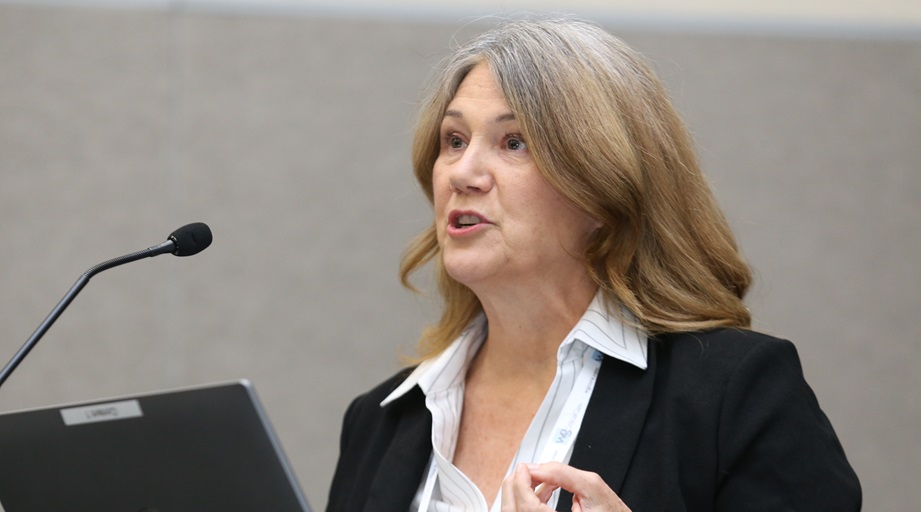
Health-system pharmacists gathered Dec. 5 at the Midyear Clinical Meeting & Exhibition in Anaheim to discuss highlights from the newly released ASHP/ASHP Foundation Pharmacy Forecast Report and how pharmacists can leverage the collective wisdom of colleagues into their strategic planning.
The Pharmacy Forecast, now in its 12th edition, draws its findings from a survey of more than 250 pharmacy leaders from across the United States on key topics impacting health systems.
“This session and the report help me think about and understand the changes that we’re all seeing in the healthcare environment,” said Pharmacy Forecast Editor Joseph T. DiPiro, associate vice president for health sciences at Virginia Commonwealth University.
The annual Pharmacy Forecast gauges pharmacists' assessment of the likelihood of specific environmental trends impacting pharmacy practice over the next five years, as well as how prepared health-system pharmacists feel regarding those potential developments. The report also offers recommendations for how pharmacy leaders can incorporate key trends into strategic planning at their practice sites.
Suzanne Shea, vice president of system pharmacy and clinical nutrition at Sharp HealthCare, praised the “rich information” contained in the full Pharmacy Forecast and encouraged attendees to read it in full. She presented a few of the trends that pharmacists might encounter by 2028, including:
- Disease and natural disasters will double the frequency of public health emergencies impacting health systems (e.g., preparedness, temporary facilities, workforce deployment) — 75% of survey respondents said this was somewhat or very likely, but only 55% considered themselves prepared.
- Value-based payer contracts will include incentives when health systems demonstrate care equity (e.g., similar outcomes of care regardless of race, gender, location) — 76% said it was likely, but only 61% felt prepared.
- Formulary and policy decisions for ultra-high-cost medications (e.g., rare and orphan drugs, gene therapy, CAR-T) will be decided by payer or service line stakeholder, and as a result, will weaken the scope of authority of their health system's pharmacy and therapeutics committee — 78% said it was likely, but only 56% felt prepared.
- State boards of pharmacy will develop regulations allowing the use of artificial intelligence (AI) or other technology in place of pharmacist order review and verification — 44% said it was likely, but only 33% felt prepared.
Shea’s presentation was followed by a panel discussion facilitated by Pharmacy Forecast Deputy Editor James M. Hoffman, senior vice president at St. Jude Children's Research Hospital. “We hope [this session] gets you primed to read the Forecast and ultimately use it in your planning efforts,” he said.
Panelists reflected on the findings that most resonated with them. Katrina (Katie) Derry, director of acute care clinical pharmacy programs at the University of California Office of the President, noted the “throughline” of the digital divide in both urban and rural communities and how it might undermine the healthy equity intentions of value-based contracting.
Mandy C. Leonard, senior director of drug use policy and formulary management at the Cleveland Clinic, encouraged her fellow pharmacists to figure out what AI means for practice, sooner rather than later. “[AI] is not going away … so how do we use it for good, build out guidelines, and make sure every patient has access to it?” she asked.
The report’s public health implications most struck Denise Scarpelli, vice president and chief pharmacy officer at the University of Chicago. She described the impact of gun violence, pharmacy deserts, and the mental health crisis on her urban health system. “Thinking about the survey … everything is connected. Public health issues tie into mental health issues, which tie into workforce shortages, which opens up opportunities for AI,” she pointed out. “It’s all intertwined.”
The Pharmacy Forecast also prompted dialogue about the ebb and flow of drug shortages, the possibility of interstate pharmacy licensures, and whether pharmacists should oversee or administer medications to make up for nursing shortages.
The report is relevant not only for pharmacy executive leaders, the panelists agreed. The insights could help pharmacy students, residents, and early-career professionals broaden their perspectives of the profession. “I think it’s eye-opening for them … to learn about other areas of pharmacy they might want to think about,” said Leonard.
“This is one of the sessions I look forward to every Midyear,” remarked one member of the audience. “It really gets the wheels turning.”
The Pharmacy Forecast is published online ahead of print and will appear in print in the Jan. 15, 2024, issue of AJHP. All editions are freely accessible at ashpfoundation.org/pharmacyforecast.








